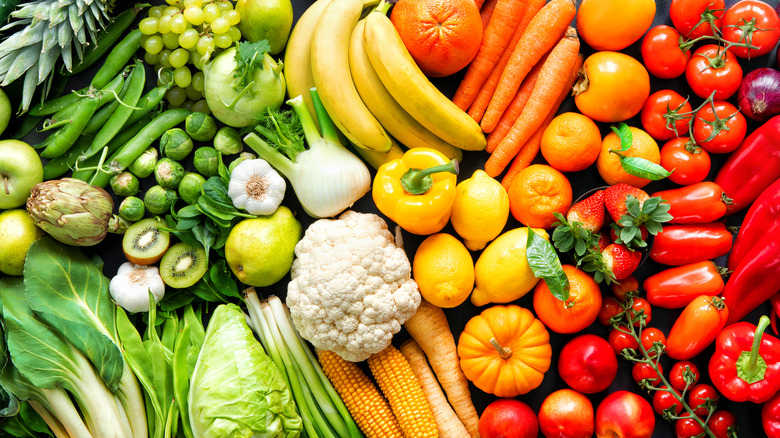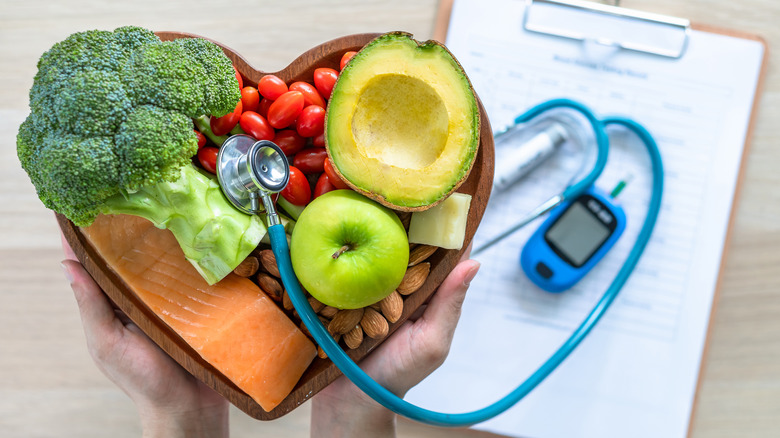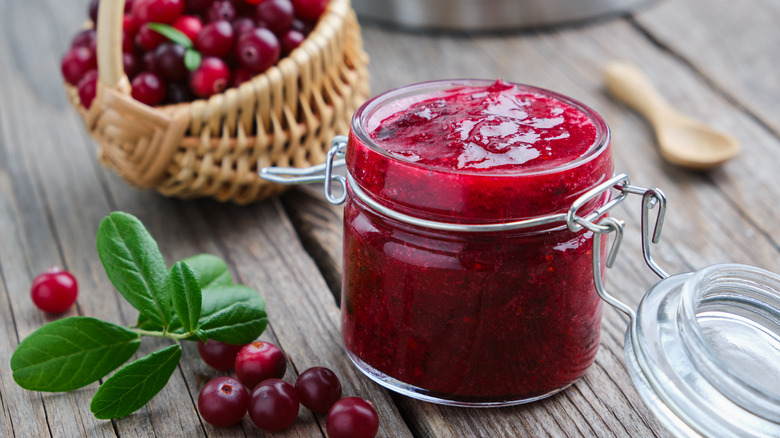Ways The Color Of Your Food Can Affect Your Health
"Taste the rainbow" — a phrase most of us have likely heard more than once. While this slogan is associated with a candy brand, it is a piece of advice most of us would benefit from following, at least when it applies to more nutritious foods. Just about any color of the rainbow can be found in fresh food, especially produce. These colors are all the result of different chemicals and nutrients, and there are so many unique colors of fruits and vegetables out there, ranging from a bright grapefruit to a deep blue plum. Therefore, it is no surprise that there are many unique nutritional benefits that can come from consuming these different pigments.
In order to get the greatest nutritional benefit from our fresh food, it is important to make sure as many colors as possible are represented in our diet. This diversity of color and nutrients ensures minimal gaps in our nutritional needs. After all, what is life without color?
Some colors may help you feel more energetic
Vitamin C is a powerful antioxidant found in many colors of fruits and vegetables, and one of this nutrient's many powers is its role in the production of energy. According to a 2020 review in Nutrients, vitamin C is necessary in the production of a compound called carnitine. Carnitine is involved in bringing fatty acids into the mitochondria, which is responsible for producing the majority of power to the cells, according to the National Human Genome Research Institute. Therefore, if someone is deficient in vitamin C, they may experience aching muscles or feel tired (via Nutrients).
There are many different colors of fruits and vegetables from which we can reap the benefits of vitamin C. One of the more potent sources of this mighty nutrient is the yellow bell pepper — according to the U.S. Department of Agriculture (USDA) FoodData Central, there are over 95 milligrams of vitamin C in ten strips of yellow bell pepper. This means five strips of raw yellow bell pepper provide almost 64% of the recommended daily average (RDA) for women and 53% of the RDA for men, according to Dietary Reference Intakes for Vitamin C, Vitamin E, Selenium, and Carotenoids. However, these benefits are not limited to yellow produce. According to Harvard T.H. Chan School of Public Health, other foods rich in this nutrient include strawberries, citrus, and broccoli.
You may be better prepared against cancer
It has been found that red and pink fruits and vegetables contain significant amounts of chemicals such as antioxidants and other nutrients that can help ward off chronic diseases such as cancer, according to WebMD. Vitamin C is a particularly potent antioxidant against cancer, and it is also one of the more commonly found antioxidants in red produce. Luckily, there is a plethora of red produce in season at different times throughout the year. Some of these options include strawberries and rhubarb in the spring, cherries and tomatoes in the summer, raspberries and radishes in the fall, and beets and apples in the winter (via the U.S. Department of Agriculture).
Carotenoids have also been found to be beneficial in the fight against cancer, and this pigment also gives many yellow, orange, and red fruits and vegetables their color, according to Oregon State University's Micronutrient Information Center. Some carotenoids are converted to vitamin A, which helps fight free radicals that could otherwise lead to cancer, according to a 2021 review in Nutrients. This study analyzed the role of vitamin A in the fight against breast cancer, and the findings uncovered the potential usefulness of vitamin A as a therapy in the development and progression of the disease.
Certain colored foods may help you lose weight
It has been found that carotenoid-containing yellow, orange, and red produce could help with weight loss. One study published in Nutrients analyzed how carotenoids may mitigate belly fat accumulation. The study looked at effects of two different carotenoids — lutein and lycopene — on different indications of metabolic syndrome in obese Japanese men, such as waist circumference and visceral fat (fat that is wrapped around organs of abdomen, per WebMD). In the study, 28 subjects consumed a beverage every day that increased their blood levels of carotenoids, and the result was decreased visceral belly fat and oxidative stress (via Nutrients).
Another nutrient useful in weight loss efforts is dietary fiber, which is found in many vibrantly colored foods, according to Rush University System for Health. By making you feel full sooner, fiber can help in reducing the amount you eat and, therefore, potentially aid in weight loss efforts, per WebMD. Green produce in particular has been found to be one of the richer sources of fiber. If increasing your fiber intake is your aim, a good rule of thumb is to look for the brighter, more intensely colored green vegetables.
You may notice your skin improve
Vitamin C has a long list of superpowers, and a benefit that can be included in that list is the ability to improve the health of your skin — so this is another area in which it's important to turn to foods high in vitamin C, usually of red, orange, or yellow color. Some of the important functions behind healthy skin are the synthesis of collagen and protection from damaging UV rays, and vitamin C is important for both, according to a 2017 article from Nutrients.
In addition to vitamin C, vitamin B also has a significant place in the maintenance of healthy skin. This benefit has been found through the discovery that a deficiency of vitamin B, particularly B12, has been associated with conditions such as atopic dermatitis, acne, and vitiligo, reported by a 2015 review in the American Journal of Clinical Dermatology. In order to avoid such conditions, look for green fruits and vegetables such as avocado, peas, asparagus, and spinach to ensure adequate intake of Vitamin B (via Real Simple).
Some pigments in foods may help your heart
It is no secret that the heart is an organ very much worth protecting — however some conditions such as high levels of cholesterol can hamper these efforts. Luckily, though, there are many colorful, edible defenses that can be employed to help reduce your cholesterol levels. For instance, white fruits and vegetables like cauliflowers, potatoes, onions, and mushrooms contain nutrients that can help lower both your blood pressure and your body's levels of bad cholesterol, according to Winneshiek Medical Center. In addition, antioxidants helpful in the defense against chronic heart conditions such as hypertension can be found in red and green produce as well.
It has also been found that increased intake of vitamin K can be particularly helpful in combating the heart condition atherosclerotic cardiovascular disease (ASCD), according to a 2021 study published in the Journal of the American Heart Association (JAHA). The study analyzed food-frequency questionnaires of subjects for their intake of vitamins K1 and K2, and cross-referenced this data with their rates of hospitalizations for ASCD. According to the study findings, subjects who consumed the highest amounts of vitamin K were at lower risk of being sent to the hospital for ASCD.
Other foods can help improve your immunity
Most of us are likely familiar with the advice to start chugging orange juice if you feel you're coming down with a cold. However, what exactly makes oranges, well, orange, and why do they help our immunity? According to MedicalNewsToday, the answer is beta carotene: the chemical that gives fruits and vegetables their orange or red color. In the body beta carotene is converted into vitamin A, which is an antioxidant that can help boost the immune system. In addition to oranges, beta carotene can be found in many other brightly colored fruits and veggies such as carrots, grapefruit, peppers, and pumpkin.
Another well-known antioxidant essential for strong immune defenses is vitamin C. According to a 2017 review in Nutrients on vitamin C and immunity, this important nutrient helps support cells of the immune system. As such, deficiency of vitamin C does not bode well for the immune system, leaving us more vulnerable to infection. Some colorful produce has been found to be particularly high in this important antioxidant, such as acerola cherries, chili peppers, and guava (via Healthline).
Your digestion may be affected
Fiber is an important component when it comes to keeping our gut happy and healthy, according to Mayo Clinic, and eating foods of certain colors may help add to our intake. Though many fruits and veggies contain fiber, several of the foods that can max your fiber intake are of a brownish color, including whole grains, beans, and legumes.
In addition to fiber, another magical nutrient that can help the gut is polyphenols, which have been found to potentially provide beneficial effects on the gut microbiome (or bacteria), according to a 2019 review from Nutrients. According to the authors, it has been found that polyphenols are difficult for the body to digest, and therefore stay in the gut longer. While hanging out in the small and large intestines, polyphenols carry out a wide range of benefits, from reducing inflammation to impacting the ecology of the intestines. Luckily, it is relatively easy to reap these gut-improving benefits, as foods of all different colors contain polyphenols. Some of the more common examples of polyphenol sources include fruits and vegetables, but other sources include options like dark chocolate and cereals, as well as beverages like coffee, tea, and even wine.
Some colorful foods can help your vision
Have you ever been told that carrots help your eyesight? This classic advice comes from the fact that carrots are rich in beta carotene, which is known to improve eye health, according to the Academy of Nutrition and Dietetics (AND). Beta carotene helps prevent eye dryness, damage from the sun, night blindness, and decline in eye health from aging. Also, because of the distinct effect it has on a plant's color, it is easy to identify other good sources of beta carotene in our food. Sweet potatoes, kale, bell peppers, and yes, carrots, are all good sources, as well as other brightly colored, non-produce food items like salmon.
One thing to keep in mind: The benefits from beta carotene can be better accessed through different methods of cooking and consuming your orange fruits and veggies. Chewing, chopping, dicing, or — even better — blending your orange fruits and veggies will break down the cell walls and make those health-enhancing nutrients more available for your body to absorb, according to Oregon State University's Micronutrient Information Center. Softening foods by cooking them can also make them easier to digest, and eating your produce along with a little fat (such as ranch dressing with carrots) can help the body better absorb fat-soluble carotenoids like beta carotene, according to a 2017 article in the American Journal of Clinical Nutrition.
Your urinary tract may benefit
While sometimes overshadowed by its ability to boost the immune system, there are many other power abilities of vitamin C, including keeping the urinary tract healthy. This is because vitamin C adds acid to the urine and therefore prevents bacteria from growing, according to Johns Hopkins Medicine. For this reason, drinking cranberry juice is recommended for the prevention of UTIs. Other fruits and vegetables rich in reddish and pink colors, like strawberries, bell peppers, and citrus fruits, are also good dietary sources of vitamin C, according to Harvard T.H. Chan School of Public Health.
In addition to vitamin C, vitamin D has also shown to have a role in maintaining urinary tract health — according to the Mayo Clinic, a deficiency in vitamin D has been associated with increased urine frequency. A number of protein sources, all of different colors, are good sources of vitamin D, including egg yolk, salmon, swordfish, tuna, beef liver, and sardines (via Harvard T.H. Chan School of Public Health). For this reason, much as you should consume a range of colorful produce, it's also important to vary the color of your protein, especially if you are trying to increase your dietary vitamin D intake.
You may find your bone health improves
Vitamin A has received a lot of attention for its potential bone-improving benefits, according to American Bone Health. There are various sources that convert to vitamin A, one of which is carotenoids, per this review from the Journal of Clinical Densitometry. Carotenoids have been found to be helpful in maintaining strong bones by providing anabolic effects (per this review from the Journal of Biomedical Science), and different types of carotenoids are commonly found in orange and yellow produce (per Today's Dietitian). These carotenoids include alpha-carotene and beta-carotene, both of which are associated with supporting bone health. So, if you are trying to set your bones up for long-term success, load up on those bright orange and yellow fruits and vegetables to keep up your carotenoid intake.
Another form of vitamin A important in supporting your skeleton is retinol. Some of the more major sources of retinol are orange and yellow as well, but they are not produce. Eggs, cheese, meat, and fish are all great sources of retinol, according to the U.K.'s National Health Service (NHS). However, one note of caution: Too much vitamin A can also have some negative impacts. According to American Bone Health, elevated levels of vitamin A have been found to be associated with increased incidences of bone fractures.
Some edible colors may help with aging
If a health goal of yours is to combat signs of aging, there are many different colors of produce to choose from that can be helpful. Some of these color options include green broccoli, blue blueberries, and red bell peppers, according to Healthline – and picking a range of colors will provide more diverse benefits, ranging from antioxidants to help stave off cancer, vitamin C to support collagen synthesis, carotenoids to combat inflammation, and many vitamins and minerals to help with skin elasticity.
While there are many nutrients to be appreciated in the fight against aging, anthocyanin in particular has received attention for its usefulness in combating a multitude of age-related ailments — one 2021 research review published Molecules noted its possible use in both treating and preventing health problems like bone loss, neurodegenerative diseases, cancer, and more. Anthocyanin usually manifests in a blue, purple or red color, and is found in many berries.
Food of some colors may be important for those of childbearing potential
Folic acid is an vital nutrient for a healthy pregnancy and fetal development. While deficiency in folic acid is rare, pregnant and lactating are more likely to experience deficiency due to their increased needs, according to Harvard T.H. Chan School of Public Health. Folic acid deficiency during pregnancy has been linked to various health problems for the developing child, including congenital heart defects, neural tube defects like spina bifida, as well as cleft lip and palate, according to Healthline. It is particularly important to ensure adequate levels of folic acid when planning to become pregnant, as some defects occur early in gestation. The RDA for women is 400 micrograms, but this increases with pregnancy; the RDA for pregnant women is 600 micrograms, and 500 micrograms for lactating women (via Harvard T.H. Chan School of Public Health).
To add to their already numerous benefits, spinach and other leafy vegetables are rich in folic acid. Spinach, in particular, packs a punch — half a cup of cooked spinach contains 131 micrograms (or over 32% of a women's RDA) of folic acid, according to WebMD.
Your blood pressure could improve
Happily, many colors of produce are associated with reducing blood pressure. Of the red fruits and vegetables, berries and beets have been known to help combat raised blood pressure, according to MedicalNewsToday. There is also the humble yellow banana which, due to its potassium content, is effective against hypertension. In addition to these bright pigments, don't overlook the pale or brown-colored food options such as garlic and oats, both of which have been found to be helpful when trying to reduce blood pressure.
In addition, it is no surprise that green vegetables are also included on the list of blood pressure-reducing foods. In a 2018 study published in Circulation on the impact of different colors of fruits and vegetables on blood pressure, green vegetables showed the greatest impact on lowering systolic blood pressure (the pressure of the heart pumping blood out to the arteries, per Mayo Clinic).
The color of your food can have behavioral impacts, both positive and negative
Some food contains added colors, and depending on the particular colorant, this can either help or hurt the food's health benefit. Despite the enticing names of some food coloring, like Brilliant Blue (aka Blue #1) or Sunset Yellow (aka Yellow #6), artificial colors have been linked to an increase in behavior issues, particularly in children (via UK Journal of Pharmaceuticals and Biosciences). Indeed, one 2004 study in Archives of Disease in Childhood looked at how different artificial food colorings impacted behavior in 3 year-olds, and the results showed an increase in hyperactivity when the children received the artificially colored beverage compared to the placebo, as well as compared to the week when they did not consume any artificial colors.
But while synthetic or artificial colors should probably be minimal in one's diet, the story is different with natural added colors: According to a 2016 critical review in the UK Journal of Pharmaceuticals and Biosciences, natural food colorants are not only safe to consume, but may have some positive impacts on the consumer's health, such as antioxidant, anti-arthritic, and anti-inflammatory effects.















